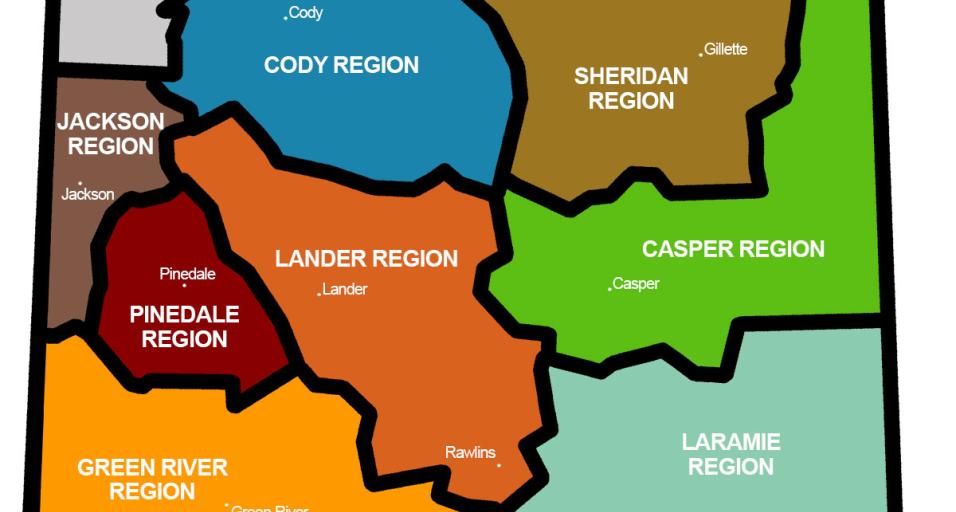Wyoming Game and Fish Department wildlife managers report typical to mild conditions heading into spring, with only pockets of the state experiencing harsh weather. But some late springtime storms may still bring significant snowfall and colder temperatures. Wildlife survival, especially mule deer and pronghorn, has so far been high. Here’s a breakdown of each region’s wildlife outlook in anticipation of hunts on the horizon.
Casper region
Wildlife survived the winter in the Casper area at an above average rate, thanks to little snow, warm temperatures and exposed forage throughout most of the region. Winter in the Black Hills was more typical, with persistent snow and colder temperatures. But that shouldn’t put a damper on turkey hunting, though. Birds are on the rebound there, which may bring an exciting spring season. Elk populations in the area remain over established objectives, with the fall hunting season designed to maximize cow harvest and mature bull hunting.
Justin Binfet, the Game and Fish wildlife management coordinator in Casper, highlights pronghorn opportunity as the shining star.
“We had good pronghorn survival and reproduction over fours years and populations have really rebounded in the Casper region,” he said. “We are able to bring back a lot more hunting opportunity — there’s been an increase of nearly 6,000 licenses since 2014.”
Sheridan region
The Sheridan area follows in Casper’s footsteps with mild conditions, the exception being from Gillette north to the Montana border. More elk and deer found their way to haystacks during the worst part of the winter, but the losses to deer, pronghorn and elk were no more than during an average year.
Dan Thiele, Sheridan wildlife management coordinator, predicts good mule deer and turkey hunting; pronghorn, too, if hunters can get access to private lands. Elk and whitetail deer have also done well this past year and should be plentiful.
Cody region
Farther west, the Cody area had markedly different winter conditions within the Bighorn Basin, but most areas experienced normal precipitation and temperatures. One exception was on the west slope of the Bighorn Mountains from Shell to south of Ten Sleep. In this area, higher-than-normal snowfall stuck, but there wasn’t significant die-off of deer and pronghorn.
Bighorn sheep in the Absarokas wintered at high elevations where there was plenty of forage. Moose populations in the region remain stable and a similar season structure is proposed for the fall.
“The only weather related change to hunting seasons we are proposing is a 4-point antler restriction for mule deer in the Upper Shoshone deer herd to improve buck numbers after last year’s severe winter,” said Tim Woolley, Cody wildlife management coordinator.
Jackson/Pinedale regions
The Jackson and Pinedale regions forecast a high survival rate for big game after one of the most mild winters on record. Elk wintering on the National Elk Refuge received no supplemental feeding for the first time since 1981. Even with the mild conditions, Area Wildlife Coordinator Doug McWhirter says the hunting outlook is variable.
“Deer hunting will still be difficult because of last year’s winter — that's why we shortened the deer season, reduced the nonresident quota, and implemented a 3-point or better restriction in 2017,” he said.
Elk hunting should be good, depending on the weather. Hunters who are lucky enough to draw a pronghorn, bighorn sheep, mountain goat or moose tag can expect a favorable season; bison success in Jackson is almost entirely related to in-season weather, so hunting can be somewhat challenging.
Lander region
Mild conditions, improved habitat and more moisture in the Lander region means good pronghorn hunting for the fall. Elk numbers remain steady. Mule deer, which have been declining due to poor fawn production, are increasing in some herds while others still struggle.
“Of the five mule deer herds within the Lander region with population size goals, two are at and three are below objective. Along with increased fawn survival, buck to doe ratios increased to an average of 33/100. Though that is not the case in the Sweetwater herd unit, hunt areas 96 and 97, where the buck ratio declined to 18/100,” said Daryl Lutz, the Lander wildlife management coordinator.
Bighorn sheep lamb production in the Whiskey Mountain herd was once again alarmingly low at 8/100 and continues to be a grave concern for wildlife managers. Low numbers of lambs have been a problem in the herd for more than 20 years. While it has certainly impacted population growth, there are still rams available for harvest. Hunter success in 2018 shouldn’t be impacted, though license numbers have been reduced.
Green River region
The Green River region experienced an extremely mild winter. Mule deer numbers boosted, with nearly all fawns surviving, which may speed up recovery of last winter’s losses. Hunters can expect a good pronghorn and elk season. Deer will be better than once anticipated, with the Baggs area noted as exceptional.
However, conditions were so mild that Wildlife Coordinator Mark Zornes fears early-spring drought conditions in the lower country. A looming drought that reduces forage could have an impact on wildlife body conditions later in the year, and the number of fawns that make it to an age where they can reproduce could be low. Ultra dry conditions will also impact upland game bird chick production.
Laramie region
The Laramie region’s mild winter kept most wildlife and hunting seasons at status quo. Corey Class, Laramie wildlife management coordinator, notes that herds are stabilizing across the region, with some of the highest mule deer and pronghorn buck ratios in the past 20 years. The Laramie region remains a prized destination for elk hunters, with the top three areas for harvest in the state in the areas of Laramie Peak, the Snowy Range and the Sierra Madres. The Snowy Range moose herd remains stable. If hunters draw the sought-after license, expect high quality bulls. Class hints at concern of a drought in the summer, but there are still many months for spring snow and summer rains to assist wildlife.


